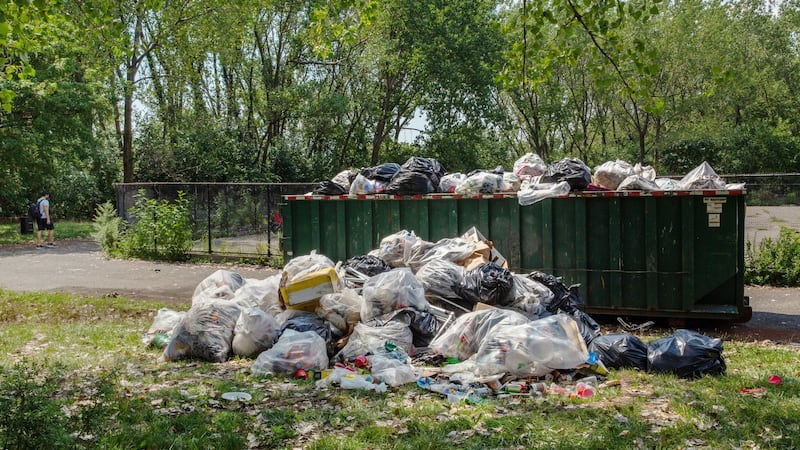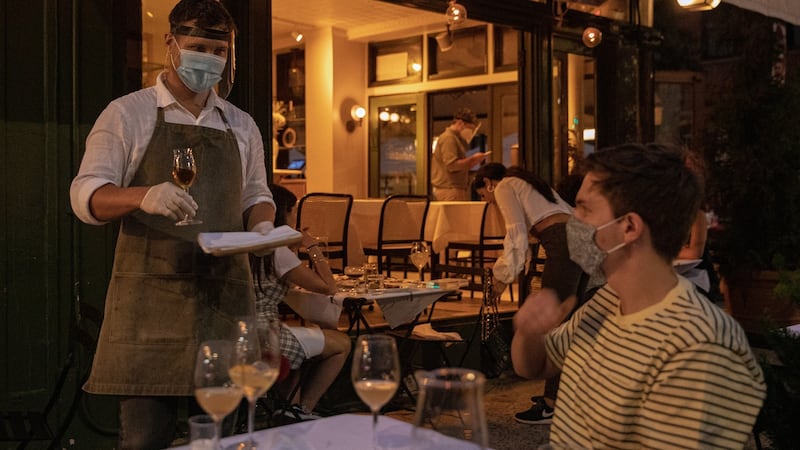Shabazz Stuart was one year old when the TV sitcom Seinfeld first went on air, and seven when the much-loved show about nothing broadcast its final episode. He’s only ever known it as one of those late-night repeats that are fun to watch when you’re at a loose end.
But this week there was no avoiding Seinfeld, or at least its creator and lead actor Jerry Seinfeld who roared back into the public eye with an opinion piece headlined "So You Think New York Is 'Dead'".
The comedian was responding to a provocative post on LinkedIn by James Altucher, a hedge-fund manager who owns an Upper West Side standup comedy club where Seinfeld occasionally appears.
Seinfeld lambasted Altucher as a "putz" for having argued that New York City was "dead forever".
According to Altucher, the pandemic has turned Midtown into Ghost Town and sent his Wall Street buddies hightailing it for the exit, probably never to return.
Seinfeld had a pithy riposte to that: “Shut up. I will never abandon New York City. Ever.”
But Stuart, from his vantage point in a multi-occupied brownstone in Crown Heights, Brooklyn, found this highly public celebrity spat over the future of his city bemusing.
Here were two hyper-wealthy Manhattanites going at each other in terms to which Stuart, like millions of other struggling New Yorkers in the outer boroughs, simply couldn’t relate.
“I don’t know if it’s very useful to have members of the ultra-rich elite talking about whether New York is dead,” he told the Guardian.
“Their arguments aren’t very persuasive to my friends wondering whether to stay or leave, as none of us have that kind of money.”
Wrong question
Stuart thinks that to ask “Is New York dead?” is posing the wrong question. Look instead at the structural problems that were festering in the city long before Covid-19 came along.
"As a lifelong New Yorker I can understand Seinfeld wanting to be a cheerleader for the city, but that just masks the challenges we have. Covid just lit the match - the TNT has been here for some time."
Does it make sense to pay all this rent when I could go to Philadelphia or Pittsburgh and have a higher quality of life?
Stuart (31) is an African American New Yorker who runs a startup, Oonee, that aims to build secure bike parking facilities across the city. His company has been successful in other urban centers across the US, but has struggled to elicit a positive response from New York authorities.
It’s the reverse of the Big Apple’s vaunted image as a cutting-edge and thrusting city where new ideas are born and flourish.
“New York lives on its reputation of being big and bold, of cultivating new ideas, but that’s not been our experience. The city is not adventurous, it’s complacent,” he said.
Under the pandemic all the things Stuart loved most about New York - the restaurants, the club scene, going to get a drink at 4am, the museums - have largely shut down or been curtailed.

Trash
Then there’s the trash, another long-term feature of life in New York that bugs him. “I’m on the street right now and there’s trash everywhere,” he said. “I love New York dearly, but I’ve never been in another city with such a waste management problem.”
But the main canker, one that also preceded the arrival of coronavirus by many years, is the cost of rents. Surveys have shown that more than four out of 10 New Yorkers who rent are “burdened”, meaning they spend a third of their income or more on housing, and of those more than half pay 50 per cent or more.
Stuart is one of those “severely burdened” New Yorkers. He currently pays himself a pandemic-reduced salary of $2,000 a month - $1,400 of which disappears on a single bedroom in his shared brownstone.
Now he finds himself not alone. Every one of the occupants of the seven bedrooms in his house, he said, is asking the same thing: “Does it make sense to pay all this rent when I could go to Philadelphia or Pittsburgh and have a higher quality of life?”
New York has always been paranoid about its life expectancy as a vibrant metropolis. You could call it a survival complex.
"Since King Kong climbed up the Empire State Building, the city's looked precarious," said Kenneth Jackson, the pre-eminent historian of New York based at Columbia University. "And in many ways, it is. So it's not crazy to wonder about these things."
But rumors of the city’s demise have always been exaggerated so far. After the Twin Towers attacks on 9/11 the same doom-laden predictions you hear today were rife. Then it was confidently asserted that New Yorkers would never again agree to work at the top of Manhattan’s skyscrapers, and that the subway would be abandoned for fear of further terrorism.
None of that happened, and Jackson can see a similar narrative playing out today. “Like 9/11, the city will come back from this pandemic. It will be slow, it may not be next month or even next year, but it will come back. Nobody made money betting against New York,” he said.

Recovery
The signs of recovery are to some extent already visible. Compared with the dark days of March and April, when ambulance sirens became the chorus of the city and a palpable fear of the microbe hung in the air, the city feels born again.
At its peak, New York City was recording more than 6,000 new confirmed cases of coronavirus a day, driving the total to almost 238,000 - almost exactly the same tally as the whole of Germany. The worst single day, 8 April, saw 810 recorded deaths.
Stay Home graffiti in the Williamsburg area of Brooklyn, New York, in March at the height of the pandemic in the city.Photograph: Jordan Gale/The GuardianFast-forward to today, and the daily number of new cases is hovering around 250 and the average daily death rate is around five.
In a few short months, the city has transformed itself from being the coronavirus pariah of America, indeed the world, into the Covid comeback kid. The governor of New York state, Andrew Cuomo, who presided over the initial catastrophe and has much to answer for, even has the temerity to be writing a book on his handling of the crisis.
The Covid turnaround has been so dramatic that it is easy to imagine Seinfeld enjoying the view from his penthouse window in Manhattan and giving thanks for the city's return. But Seinfeld's New York, the New York in which most of the world gets to live vicariously through movies and glossy magazines, bears very little resemblance to real life just over the Harlem River in the Bronx.
Here you don’t have to scratch the surface very far to expose the raw, bloody wounds of racial inequality. Here the pandemic has laid bare uncomfortable truths about this city.
It began with emerging patterns of sickness and death. As coronavirus took hold, it became clear that the virus was cruelly focusing its destruction on pockets of the population. Those infected with the disease died in the Bronx - which is almost 90 per cent black and Latino - at three times the rate of those in Manhattan whose largest demographic is white.
In the Bronx, you don't have time to sit around pontificating about whether New York is dead because you're too busy trying to keep yourself and your family alive
Economy
Once the virus was contained, the pain switched from death to economic misery. James Parrott, an economist at the Center for New York City Affairs at the New School, has produced a series of deep-dive reports through the pandemic that expose the severity of the crisis.
He found that while the official unemployment rate in the city was 20 per cent in June, the actual figure measured by unemployment benefits was 33 per cent. That rate rose in the Bronx to a heartbreaking 41 per cent.
Those unemployed women and men in the Bronx, largely people of color, are the New Yorkers who are excluded from the bubble in which Seinfeld and Altucher bicker. In the Bronx, you don’t have time to sit around pontificating about whether New York is dead because you’re too busy trying to keep yourself and your family alive.
Up to 5per cent of New York’s population - more than 400,000 people - are thought to have fled the city at the start of the pandemic. Some drove down Long Island to the Hamptons, others went further afield, to Florida perhaps, where Altucher now says he has started over.
Though the data remains sketchy, the evidence suggests that most of those quitters were white and wealthy. Which is logical: in poorer areas of the Bronx, Queens and Brooklyn, escape is not an option.
“The workers who have lost their jobs and income, they are the ones who are staying in New York,” Parrott said. “They are rooted here, they don’t have the luxury of relocating.”
Parrott’s research underlines the bitter inequalities buried within the job losses. While lower-income and predominantly black and Latino workers in face-to-face industries have suffered devastating levels of unemployment - 61per cent in entertainment, 56 per cent in food services, 49 per cent in hotels - the decline in lucrative Wall Street jobs has been just 3 per cent.
Hardship
Hardship is beginning to bite. At the end of July, supplemental unemployment benefits of $600 a week expired, and already applications for food stamps have surged by 13 per cent from the start of the pandemic. There are thought to be more than 2 million New Yorkers who are food insecure - a million more than before the pandemic.
Most worrying of all in Parrott’s analysis are the almost 250,000 dislocated undocumented immigrants in the city who came here to work and to forge lives but who have now fallen through the cracks and are receiving no financial assistance at all. Given their invisibility as non-citizens crouching in the shadows, the fate of this community is largely unknown.
“We’re going to see a lot more economic devastation,” Parrott said. “People are finding it increasingly hard to make the rent payments, there’s an unprecedented demand for food assistance. We are witnessing hunger.”
Uche Blackstock, a native New Yorker, has watched with mounting foreboding as the pandemic has ravaged her city. As an urgent care doctor in Brooklyn, she was there at the start when medical clinics were overflowing with sick and dying Americans, most of whom were black or brown.
Later, she observed how many of the white residents of her housing co-op in Clinton Hill left the city to hunker down in their second homes. When her two children returned to local public school recently it was disclosed that the student roll had tumbled from 1,000 children to 750.
“Black and brown communities have had a double whammy,” she said. “First the health consequences of the virus, now the economic hit of job losses.”
Despite all that, Blackstock says she has no intention of going anywhere. This city may be agonizing in its inequalities, cruel in its demands, and maddening in its complacency - but at least it is hers.
“Maybe I’m being idealistic, but I think native New Yorkers, we have a resilience that other folks lack. We understand the uniqueness of this city, what it means to live here now and long after the pandemic has gone.” Guardian












